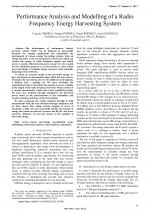| 1/2013 - 5 |
Performance Analysis and Modelling of a Radio Frequency Energy Harvesting SystemCIRSTEA, C. |
| Extra paper information in |
| Click to see author's profile in |
| Download PDF |
Author keywords
energy harvesting, experimental setup, modelling, performance analysis, radio frequency, simulation
References keywords
networks(7), sensor(6), antennas(6), link(5), materials(4), communications(4)
No common words between the references section and the paper title.
About this article
Date of Publication: 2013-02-28
Volume 13, Issue 1, Year 2013, On page(s): 27 - 32
ISSN: 1582-7445, e-ISSN: 1844-7600
Digital Object Identifier: 10.4316/AECE.2013.01005
Web of Science Accession Number: 000315768300005
SCOPUS ID: 84875296793
Abstract
The development of autonomous battery powered systems which can be deployed in inaccessible locations for sensing applications has determined the development of various energy harvesting systems. Such an energy harvester is the one developed by Powercast which can convert the energy of radio frequency signals into useful power. A model of the harvested power can prove to be a useful tool for simulation purposes as it can provide, to some extent, prior knowledge of available energy resources when optimally deploying sensor networks. To obtain an accurate model of the harvested energy we have developed an experimental setup which has been used to determine the harvested power in two different environments, a hallway and a parking lot. We have developed the experimental setup to determine the amount of power available at the output of the radio frequency harvester which consists of a current measurement system and a data acquisition system. We have also modeled through simulations the harvested power based on the characteristics of the transmitter and receiver antennas and those of the environment. We have compared the results obtained through in field measurement with the ones obtained through simulation and we have shown that within certain margins of error of maximum 2 dBm one can successfully predict the amount of energy the system can harvest. However the RF-DC and Boost converter efficiency are also key factors in the quantity of harvested energy. |
| References | | | Cited By |
Web of Science® Times Cited: 0
View record in Web of Science® [View]
View Related Records® [View]
Updated 3 weeks, 5 days ago
SCOPUS® Times Cited: 0
View record in SCOPUS® [Free preview]
There are no citing papers in the CrossRef Cited-by Linking system.
Disclaimer: All information displayed above was retrieved by using remote connections to respective databases. For the best user experience, we update all data by using background processes, and use caches in order to reduce the load on the servers we retrieve the information from. As we have no control on the availability of the database servers and sometimes the Internet connectivity may be affected, we do not guarantee the information is correct or complete. For the most accurate data, please always consult the database sites directly. Some external links require authentication or an institutional subscription.
Web of Science® is a registered trademark of Clarivate Analytics, Scopus® is a registered trademark of Elsevier B.V., other product names, company names, brand names, trademarks and logos are the property of their respective owners.
Faculty of Electrical Engineering and Computer Science
Stefan cel Mare University of Suceava, Romania
All rights reserved: Advances in Electrical and Computer Engineering is a registered trademark of the Stefan cel Mare University of Suceava. No part of this publication may be reproduced, stored in a retrieval system, photocopied, recorded or archived, without the written permission from the Editor. When authors submit their papers for publication, they agree that the copyright for their article be transferred to the Faculty of Electrical Engineering and Computer Science, Stefan cel Mare University of Suceava, Romania, if and only if the articles are accepted for publication. The copyright covers the exclusive rights to reproduce and distribute the article, including reprints and translations.
Permission for other use: The copyright owner's consent does not extend to copying for general distribution, for promotion, for creating new works, or for resale. Specific written permission must be obtained from the Editor for such copying. Direct linking to files hosted on this website is strictly prohibited.
Disclaimer: Whilst every effort is made by the publishers and editorial board to see that no inaccurate or misleading data, opinions or statements appear in this journal, they wish to make it clear that all information and opinions formulated in the articles, as well as linguistic accuracy, are the sole responsibility of the author.



